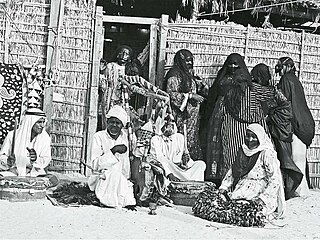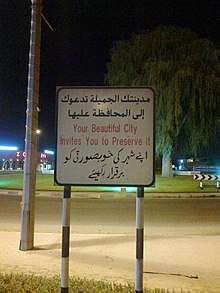Politics of the United Arab Emirates take place in a framework of a federal presidential elective constitutional monarchy. The United Arab Emirates (UAE) is a federation of seven constituent monarchies: the Emirates of Abu Dhabi, Ajman, Dubai, Fujairah, Ras al-Khaimah, Sharjah, and Umm al-Quwain.

The United Arab Emirates is a high-income developing market economy. The UAE's economy is the 4th largest in the Middle East, with a gross domestic product (GDP) of US$415 billion in 2021-2023.

The United Arab Emirates (UAE), or simply the Emirates, is a country in West Asia, in the Middle East. Located at the eastern end of the Arabian Peninsula, it shares borders with Oman and Saudi Arabia; as well as maritime borders in the Persian Gulf with Qatar and Iran. The United Arab Emirates is an elective monarchy formed from a federation of seven emirates. As of 2023, the UAE has an estimated population of 9.97 million. Emirati citizens are estimated to form 11.6% of the population; the remaining residents are expatriates, the majority of whom are South Asian. Islam is the official religion and Arabic is the official language. Abu Dhabi is the country's capital, while Dubai, the most populous city, is an international hub.

Hindus are the third largest Religious group in the United Arab Emirates and constitute around 6.6%-15% of the population in the nation. Hinduism is followed mainly by the significant Nepali and Indian population in the United Arab Emirates.
Private education in Dubai is regulated by the Knowledge and Human Development Authority. The UAE Ministry of Education is responsible for public schools in Dubai. Currently, more than 90% of school education in Dubai takes place in the private sector, served by 194 private schools offering 17 different curricula to more than 280,000 students from 182 nationalities. Dubai has 26 international branch campuses of universities from 12 different countries - including the UK, Australia and India. More than 30,000 students attend these universities, with the majority studying business, engineering and media & design. The Knowledge and Human Development Authority (KHDA) was founded in 2006 to develop education and human resource sectors in Dubai, and license educational institutes.

The Emiratis are the native citizen population of the United Arab Emirates. Within the UAE itself, they number approximately 1.15 million.
Provision of education in the UAE began shortly after the establishment of the federation with the inception of the first university in Al Ain, Abu Dhabi, the United Arab Emirates University. Since then, the country has progressed with efforts of ensuring high literacy rates, modern programs and women's share in education. It works on improving its youths education which is why the agenda 2021 has been set. The UAE currently devotes approximately 25 percent of total federal government spending to education. As of 2019, the overall literacy rate is 96%.
Mass media in the United Arab Emirates is subject to government control and censorship. Media freedom is severely curtailed in the UAE. Most UAE media is owned by the government or by groups that have ties to the government. UAE law permits the government to censor content critical of the government. Journalists and writers who criticize the government are subject to repression.

Emirati passports are passports given from the government of the United Arab Emirates (UAE) to Emirati citizens for the purpose of international travel.

Emirati cuisine is the local traditional Arabic cuisine of the United Arab Emirates. It is part of Eastern Arabian cuisine and shares similarities with cuisines from neighboring countries, such as Omani cuisine and Saudi Arabian cuisine, as well as influences from different Middle Eastern and Asian cuisines.

The culture of the United Arab Emirates is part of the culture of Eastern Arabia. Its historical population was a small tribal community that changed with the arrival of an influx of foreign nationals in the mid-20th century. Emirati culture is a blend of Arabian, Islamic, and Persian cultures, with influences from the cultures of East Africa and Indian Subcontinent. Islam has had a prominent influence on local architecture, music, attire, cuisine, and lifestyle.
Pakistanis in the United Arab Emirates include expatriates from Pakistan who have settled in the United Arab Emirates (UAE), With a population of over 1.5 million, Pakistanis are the second largest national group in the UAE after Indians, constituting 12.5% of the country's total population. They are the third largest overseas Pakistani community, behind the Pakistani diaspora in Saudi Arabia and the United Kingdom. The population is diverse and consists of people from all over Pakistan, including Punjab, Sindh, Khyber Pakhtunkhwa and FATA, Balochistan, Azad Kashmir and Gilgit Baltistan. The majority of Pakistanis are Muslim, with significant minorities of Christians, Hindus and other religions. The majority are found in Dubai and Abu Dhabi respectively, while a significant population is spread out in Sharjah and the remaining Northern Emirates. Dubai alone accounts for a Pakistani population of 400,000.
Americans in the United Arab Emirates are residents of the United Arab Emirates (UAE) who originate from the United States. As of 2015, there are over 50,000 Americans living in the country.
Iraqis in the United Arab Emirates have a population exceeding 200,000, closer estimates report a total of 250,000 Iraqis in the Emirates. Since its independence, Iraqis have contributed in the development of UAE, as engineers, politicians and in other fields. Most notably Adnan Pachachi who was appointed as Minister of State in the first Government of the Emirate of Abu Dhabi. Pachachi is known for his role in submitting the UAE's application for membership in the United Nations. In a meeting with Prime Minister of Iraq, Mustafa Al-Kadhimi, Mohamed bin Zayed Al Nahyan stated that "Iraqis have contributed in building the UAE, and there are many of them who worked, built, developed and helped build the Emirates, and we mention this credit to them, whether engineers, doctors, or even politicians and others. There are still many Iraqis living in the UAE, and they are credited.”

Emirati Americans are Americans who have roots, origin, and descent from the United Arab Emirates.
Expatriates in the United Arab Emirates represent about 88% of the population, while Emiratis constitute roughly 12% of the total population, making the UAE home to one of the world's highest percentage of expatriates.

EmiratiArabic refers to a group of Arabic dialectal varieties spoken by the Emiratis native to the United Arab Emirates that share core characteristics with specific phonological, lexical, and morphosyntactic features and a certain degree of intra-dialectal variation, which is mostly geographically defined. It incorporates grammatical properties of smaller varieties within the UAE, generally of tribal nature, which can be roughly divided into a couple of broader sub-varieties: the first spoken in the Northern Emirates of Dubai, Sharjah, Ajman, Umm al-Quwain, and the western part of Ras al-Khaimah; the second in the eastern part of the country, mainly in Fujeirah, Dibba, Khor Fakkan, Hatta, Kalba, and the eastern part of Ras al-Khaimah; the third in Abu Dhabi including the oasis city of Al Ain, the dialect is also seen in the Omani region of Al-Buraimi. Emirati Arabic varieties can also be distinguished based on environmental factors, including variations associated with Bedouin communities, coastal, agricultural, and mountainous regions.

Polish-Emirati relations are foreign relations between the Republic of Poland and the United Arab Emirates. Poland has an embassy in Abu Dhabi, and the United Arab Emirates has its counterpart in Warsaw.

Afro-Emiratis, also known as African Emiratis and Black Emiratis, are Emiratis of full or partial Black African and Afro-Arab descent. They are mostly concentrated in the Northern Emirates. Despite their minority status within the broader Emirati population, they have a significant historical presence and cultural contribution, especially in sports and music.











